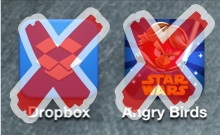Top 10 banned apps on iOS and Android BYOD devices


Yes, there are pitfalls to BYOD, and one of them is that corporate security policies can make your device feel like it doesn't belong to you. And one restriction that companies can place on you is what you can – and can't – install on your BYOD smartphone or tablet.
But what apps are businesses blacklisting most often on BYOD devices?
Fiberlink, the company behind the MaaS360 mobile device management software, examined data for more than 2 million devices that it secures for companies around the world to get a picture of what's allowed, and what's not allowed, on BYOD devices.
Top 10 Blacklisted Apps: iOS Devices
- Dropbox
- SugarSync
- BoxNet
- Google Drive
- Pandora
- SkyDrive
- Angry Birds
- HOCCER
- Netflix
Top 10 Blacklisted Apps: Android Devices
- Dropbox
- Netflix
- Google+
- Angry Birds
- Google Play Movies & TV
- Google Play Books
- Sugarsync
- Google Play Music
- Google+ Hangouts
So, want to play Angry Birds on your BYOD device? Sorry, you're outta luck. Catch up on some of your favorite TV shows on Netflix while on the train? Tough. Share files on DropBox? 'Fraid not.
Fiberlink has also crunched the data to find what are the most popularly whitelisted apps for iOS and Android.
Top 10 Whitelisted Apps: iOS Devices
- iBooks
- Adobe Reader
- Citrix Receiver
- Numbers
- Dropbox
- Pages
- itunes U
- Keynote
- WebEx
Top 10 Whitelisted Apps: Android Devices
- NITDroid
- Adobe Reader
- Lookout
- Skype
- Citrix Receiver
- Android Translator
- Antivirus
- ZXing
- Google Maps
See also: Potential pitfalls of BYOD
It's interesting to note that Dropbox appears on in the top 10 blacklist for both iOS and Android, while at the same time appearing in the top 10 of whitelisted iOS apps. This shows that while some companies see Dropbox as being a threat, other embrace it. Outside the top 10, this is likely to be the case for most apps, as companies tailor the blacklists and whitelists to their specific needs.
But how common is the practice of whitelisting and blacklisting apps?
Crunching the numbers further, Fiberlink found that less than 10 percent of customers has blacklists of whitelists in place for iOS devices, with that number falling to less than 5 percent for Android devices. Manufacturing and service industry customers topped the list when it came to blacklists, while consumer/retail and service industries were the ones most likely to have whitelists in place.
Getting even deeper into the data, Fiberlink found that, on average, customers blacklisted 5 iOS apps and 7 android apps, while whitelisting 16 and 10 apps for the respective platforms.